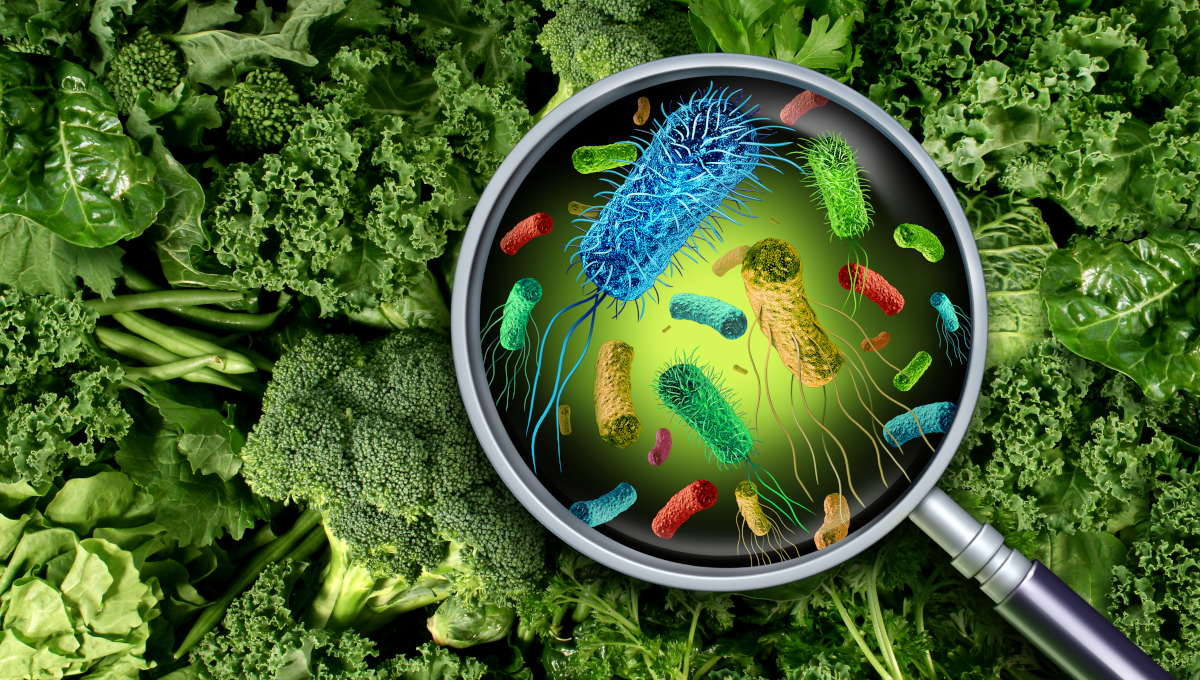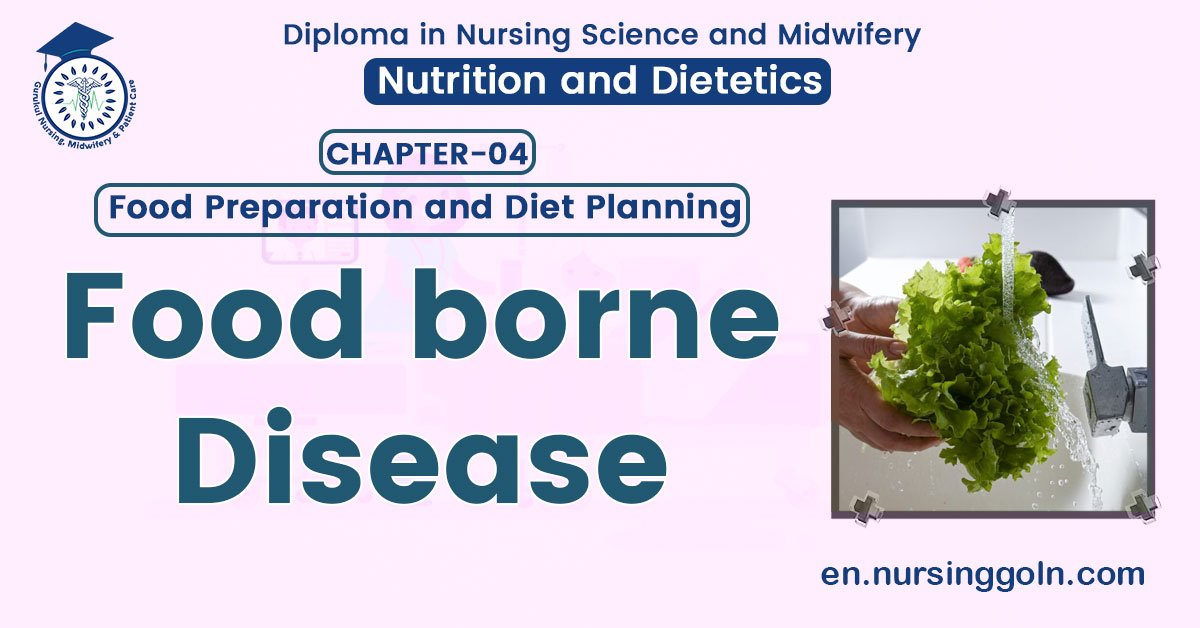Food borne disease – This book covers the entire syllabus of “Nutrition and Dietetics” prescribed by BNMC-for all Diploma in Nursing Science and Midwifery students. We tried to accommodate latest information and topics. This book is examination friendly setup according to the teachers’ lectures and examination’s questions. At the end of the book previous university questions are given. We hope in touch with the book students’ knowledge will be upgraded and flourished. The unique way of presentation may make your reading of the book a pleasurable experience.

Food borne disease
Definition of food borne disease:
The term “food borne disease” is defined as – “A disease, usually either infectious or toxic in nature, caused by agents that enter the body through the ingestion of food.”
(Ref: K. Park/23/657)
Classification of food borne disease:
A. Food borne infections:
1. Bacterial diseases:
- Typhoid fever.
- Paratyphoid fever.
- Salmonellosis.
- Staphylococcal intoxication.
- E. coli diarrhea.
2. Viral diseases:
- Viral hepatitis.
- Gastroenteritis.
3. Parasites:
- Taeniasis Hydatidosis.
- Trichinosis.
- Ascariasis.
- Amoebiasis.
- Oxyuriasis.
B. Food borne intoxications:
1. Due to naturally occurring toxins in some foods”
- Lathyrism.
- Endemic ascitis.
2. Due to toxins produced by certain bacteria
- Botulism.
- Staphyloccus poisons.
3. Due to toxins produced by some fungi.
- Aflatoxin.
- Ergot.
- Fusarium toxins.
4. Food borne chemical poisoning
- Heavy metals, e.g. mercury (usually in fish) and lead (in canned food)”
- Oils, petroleum derivatives and solvents. (E.g. Trycresyn phosphate or TCP)”
- Migrant chemicals from package materials.
- Asbestos.
- Pesticide residues (DDT, BHC).
(Ref: K. Park/24/697)
Prevention of food borne diseases:
Food borne disease may be one of the most common causes of acute illness; many cases and outbreaks are unrecognized and unreported.
Prevention and control of these diseases:
1. Avoidance of food contamination.
2. Destruction or denaturation of the contaminants.
3. Prevention of further spread or multiplication of contaminants.
4. Educating food handlers about
- Proper practices in cooking.
- Storage of food.
- Personal hygiene.
Toward this end, World Health Organization (WHO) has developed “Ten Golden Rules for Safe Food Preparation.” These are as follows:
1. Choose foods processed for safety.
2. Cook food thoroughly.
3. Eat cooked foods immediately.
4. Store cooked foods carefully.
5. Reheat cooked foods thoroughly
6. Avoid contact between raw food and cooked food.
7. Wash hands repeatedly”
8. Keep all kitchen surfaces meticulously clean.
9. Protect food from insects, rodents and other animals.
10. Use safe water.
(Ref: June D Thompson’s/24/543)

Causes of food borne disease:
| 1. Non-bacterial food poisoning: | Non-bacterial food poisoning is caused by certain plants, sea food and chemicals. |
| 2. Bacterial food poisoning: | Salmonella occurs due to contaminated meat, milk, milk products, sausages, custards, egg, and egg products. |
| 3. Staphylococcal food poisoning; | Staphylococcus food poisoning occurs due to contaminated salads, milk and milk products |
| 4. Botulism: | Botulism occurs due to contamination of home canned vegetables, smoked or picked fish and home-made cheese. |
(Ref: Onila Salin’s Essential nutrition/1/90)
Clinical features of food borne disease:
1. Diarrhoea.
2. Fever.
3. Abdominal pain.
4. Vomiting.
5. Salmoneila septicaemia may be associated with osteomyelitis and septic arthritis.
6. Symptoms last usually for 3-5 days.
(Ref: K. Park/234/657)
Food allergy:
Food allergy may be defined as abnormal tissue reactions that may occur in some individuals after consuming a particular food or group of food.
(Ref: T. K. Indrani/1/236)

Treatment of food allergy:
The allergic manifestations are treated by drugs. Different types of diets are used in the treatment of allergy.
1. Drugs: For the treatment of severe allergic manifestations, anti-allergic drugs such as cortisone or antihistamines. The allergic reactions usually disappear after treatment.
2. Synthetic diet: Patients who are allergic to common foods show improvement when they are fed on a synthetic diet. Such diets are used in only severe cases.
3. Elimination diet: The elimination diets suggested by Rowe (1944) can be used for the treatment of allergy. The patient is first treated with anti-allergic drugs. When the allergic reactions, are cured, he is placed on one of the diets, which on the basis of skin test and dietary history is not likely to cause allergic reaction.
4. Restricted diet: When the subject tolerates one of the elimination diets and other foods such as milk, wheat and meat should be added (one at a time) to the elimination diet. The new diet should be continued for 2 to 3 weeks. If the new food added to the diet does not cause any allergic reaction, then it can be consumed for a longer period in order to make sure that it is well tolerated by the patient. On the other hand, if it causes allergic reaction, it should be eliminated completely from the diet. In this way, the foods which cause allergic reaction in the patient can be found out and the same should be completely eliminated from the diet.
(Ref: T. K. Indrani/1/237-238)
Read more:
